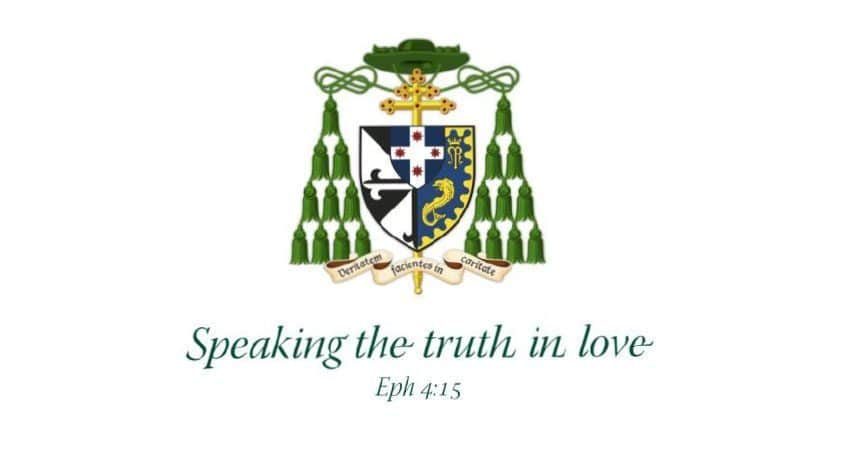HOMILY FOR THE SOLEMNITY OF OUR LORD JESUS CHRIST, KING OF THE UNIVERSE YEAR A + INVESTITURE CEREMONY FOR THE EQUESTRIAN ORDER OF THE HOLY SEPULCHRE OF JERUSALEM

ST MARY’S CATHEDRAL, SYDNEY, 26 NOVEMBER 2023
In 1792 the baby-faced Louis Saint-Just made his maiden speech in the National Convention, the new-formed parliament of the First French Republic. For the ambitious and idealistic young Saint-Just, addressing the 800-strong assembly was an opportunity to make a name for himself. His topic was the fate of the recently deposed king, Louis XVI. Saint-Just argued that to try him would be a nonsense. Not because it meant the crown trying the crown. No, because a trial assumes the possibility that one could be found not guilty. But Louis, like all monarchs, was a tyrant. “No king can reign innocently!” he thundered.[1] If the revolution was to live, the king must die. The speech was to be a major catalyst for the execution of the king by the National Razor.
Yet the death of the king didn’t bring the peace and stability Saint-Just and co. had hoped. Instead, it accelerated a Reign of Terror. Blood flowed in the streets of Paris, as well as the coastal region of the Vendée, where thousands of Catholics were killed for resisting the revolution. Saint-Just eventually earned the moniker ‘Angel of Death’ for his insatiable appetite for guillotining political rivals.[2]
Regicide rarely brings peace and order. The Old Testament is replete with king killings,[3] and rarely was what followed an improvement. The kings of the Greeks, the Persians and the Romans met a similar fate. The great Julius Caesar, a king in all but name, was assassinated to secure the Roman republic; but this only precipitated a series of civil wars and imperia, each more brutal and tyrannical than the last. In the ninth and tenth centuries popes were assassinated willy-nilly, and the Church fell into a terrible state. The British sport of regicide gave Shakespeare many tragedies to write. In one the king laments:
For God’s sake let us sit upon the ground
And tell sad stories of the death of kings:
How some have been depos’d, some slain in war,
Some haunted by the ghosts they have deposed,
Some poisoned by their wives, some sleeping kill’d.
All murder’d—for within the hollow crown
That rounds the mortal temples of a king
Keeps Death his court…[4]
In Shakespeare’s own lifetime Mary Queen of Scots was beheaded by her cousin Elizabeth. Her grandson, Charles I of England, Scotland and Ireland, would suffer the same fate. Thereafter followed a period of military tyranny, then anarchy and, after a brief restoration, a second and more “glorious” revolution, the deposition of another Stuart, and more bloodshed. Despite the talk of kings exercising a sacred office and even ruling by divine right, history suggests their reigns were often precarious.
At His trial before Pilate, Jesus was quizzed about His kingship. “Are you the King of the Jews?” the governor asked (Mt 27:11 et par.). The interrogation is telling. In this Roman’s thinking, the divine auctoritas or mandate of kings was demonstrated by opulent splendour, power of governance, force of armies. This Galilean had nothing of the sort. Yet there was something about Him. It was unsettling.
Jesus’ reply perplexed him further. Yes, I am a king, but my kingdom is a reign of truth, my subjects, seekers after truth, their king, the witness to truth. Pilate’s famous retort is “What is truth”? (Jn 18:37-38)
Jesus, the truest ever king, would suffer the fate of many before and since. The fickle crowd hailed Him one day with “God save the king” and condemned Him the next with “Crucify him, crucify him” (Mt 21:9; 27:22-23). As God the Father faced open revolt against His authority in Eden, now God the Son did so in Jerusalem. And in a precedent to Saint-Just, Caiaphas would count Jesus’ death a small price to pay for peace and order: “better one man die for the sake of the people” (Mt 27:24; Jn 11:50; 18:14).
But, for once, killing the king did indeed bring peace. For once the king’s murder was not the termination of His reign but its vindication and extension. Christ’s selfless sacrifice was the beginning of the end for the powers of Evil, Tyranny and Death (cf. 1Cor 15:20-26). It was the rescue of stray sheep foretold in Ezekiel’s prophecy and David’s psalm today (Ezek 34:11-17; Ps 22(23)). Caiaphas, ironically, was right: one man’s death would indeed save the people, if not in the way he’d imagined. The death of the King of the Jews would not fix all the problems in the Holy Land—as is all too evident right now—but it would initiate a new way of thinking and being, a kingdom “not of this world”, a reign of truth, peace and love that makes claims on every human heart, and promises life beyond the grave.

In the Christ the King window of our cathedral, Christ is depicted with a royal orb in his left hand and named Lord of Heaven. Angels carry His sword of judgment and His cross now flowering with new life. Never again will this king be killed. But today’s Gospel tells us He will, in the end, judge His subjects with that sword of justice and lily of redemption. His test will be our charity: whether we cared for the hungry, stranger, sick, imprisoned. Having judged those who care for the needy to be His flock, the citizens of His kingdom of truth and love, He will, according to Paul, transfer the kingdom to His Father (1Cor 15:20-26). Hence our window has Him with orb as true king of the world, but carrying no sceptre or pastoral staff or in His other hand. Instead, with His free hand, He points upwards to heaven. If you live after this pattern, He says, you ready yourself for that kingdom!
[1] Simon Schama, Citizens: A Chronicle of the French Revolution (UK: Penguin Books, 1989), 551. Also see R.R Palmer, Twelve Who Ruled: The Year of Terror in the French Revolution (Princeton University Press: New Jersey, 2017), 301.
[2] https://www.historytoday.com/miscellanies/french-revolutions-angel-death
[3] Saul (1Sam 31:4-5; 1Chr 10:4-5), Ishbosheth (2Sam 4:5-7), Nadab (1Kgs 15:25-29), Elah (1Kgs 16:9-10), Jehoram of Israel (2Kgs 9:24-25), Ahaziah (2Kgs 9:27; 2Chr 22:9), Athaliah (2Kgs 11:15-16; 2Chr 23:14-15), Jehoash (2Kgs 12:20-21; 2Chr 24:25-26), Amaziah (2Kgs 14:19; 2Chr 25:27), Zachariah (2Kgs 15:10), Shallum (2Kgs 15:14), Pekahiah (2Kgs 15:25), Pekah (2Kgs 15:30), Amon (2Kgs 21:23; 2Chr 33:24).
[4] William Shakespeare, Richard II, Act 3 Scene 2.
INTRODUCTION TO SOLEMNITY OF OUR LORD JESUS CHRIST, KING OF THE UNIVERSE YEAR A + INVESTITURE CEREMONY FOR THE EQUESTRIAN ORDER OF THE HOLY SEPULCHRE OF JERUSALEM | ST MARY’S CATHEDRAL, SYDNEY, 26 NOVEMBER 2023
Welcome to St Mary’s Cathedral Sydney for our Mass for the Solemnity of Our Lord Jesus Christ, the Universal King. At the end of one liturgical year and on the cusp of the Advent of the next, this feast celebrates Christ’s sovereignty over all time and space.
The coming Tuesday will be a dark day for New South Wales, as the law allowing euthanasia and assisted suicide comes into effect. Even Catholic nursing homes run by nuns will be required to host the killing of patients on their premises and enable it in various ways. NSW Health also wants to override the professional objections of public hospital doctors. And just as the state is providing the social choice of an early death, our government is reducing access to high-quality palliative care.
Bracket creep will doubtless follow: after the terminally ill will come the chronically ill and disabled; after the physically sick, the depressed and lonely; after adults who volunteer will come the unconscious and children who cannot. In Canada, where euthanasia was supposed to be a last resort for the already dying, someone is now killed every forty minutes and it is even being proposed as a solution to poverty and homelessness. May the Lord of Life and Prince of Peace, whose advent we will soon celebrate, renew compassion and respect for every human life.
I welcome members of the Order of the Holy Sepulchre of Jerusalem who are joining us for Mass today. Concelebrating with me are the Order’s chaplains: Dean Don Richardson, Rev. Dr Tom Carroll, and Frs John Knight and Paul Smithers. I’m pleased to acknowledge the Lieutenant of the New South Wales Lieutenancy, Mr Justice François Kunc, and other councillors, officeholders, knights and dames of the Order. This organisation is devoted to sustaining the spiritual, charitable, and cultural works of the Church in the Holy Land, as well as preserving and propagating the faith in those lands where their help is needed now more than ever. We join the Order in the Holy Land today in praying for the reign of the Prince of Peace, and the NSW Lieutenancy in praying for more vocations to the Order. Today it is my privilege as Grand Prior of the Order in Australia to invest Mr James Lu as a new knight. Participation in this evocative ceremony renews in all Knights and Dames a profound sense of belonging to the Order and a full sharing in ideals of faith and charity. May our common prayer, which we entrust to the Virgin Mary, Mother of the Risen Christ and Queen of Palestine, be of help to the one who today embarks on a new path as a member of the Equestrian Order of the Holy Sepulchre of Jerusalem.

